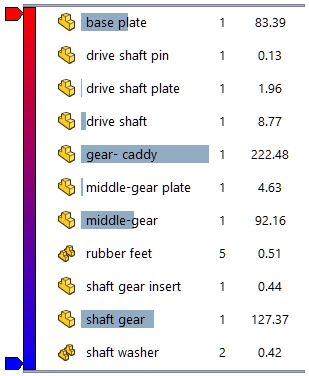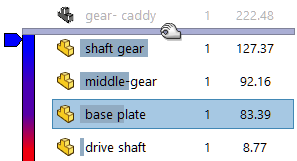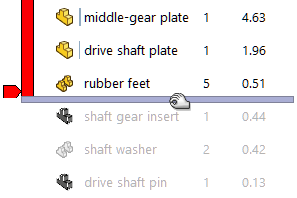From the Assembly Visualization
tab, you can rank components based on the values of their custom properties. You can
activate a spectrum of colors that reflects the relative values of the properties for each
component.
To open this tab:
Click Assembly Visualization
 (Tools toolbar or Evaluate tab on the CommandManager) or .
(Tools toolbar or Evaluate tab on the CommandManager) or .
The Assembly Visualization tab
 in the FeatureManager design tree panel contains a list of
all components in the assembly, sorted initially by file name. There are three
columns:
in the FeatureManager design tree panel contains a list of
all components in the assembly, sorted initially by file name. There are three
columns:
- File name
- Quantity
- Property (initially Mass)
Click a column header to sort by its
parameter.

Buttons
| |
|
|
 / / 
|
Show/Hide Value Bars
|
Available for numeric
properties. Turns the value bars off and on. When the value bars
are on, the component with the highest value displays the
longest bar. You can define the length of the bars to be
calculated relative to the highest-value component or relative
to the entire assembly. |
 / / 
|
Flat/Nested View
|
Switches between:
- Nested view, where subassemblies are
indented
- Flat view, where subassembly structures
are ignored (similar to a parts-only BOM)
|
 / /
|
Grouped/Ungrouped View
|
Switches between:
|
Grouped View
|
Groups multiple instances of a
component into a single-line item in the list.
Grouped
View is useful when listing values for
properties that are identical for every instance of
the component.
|
|
Ungrouped
View
|
Lists each instance of a component
individually. Ungrouped
View is useful when listing values for
instance-specific properties, such as Fully mated, which
might be different for different instances of the
component.
|
An asterisk *
next to the group label indicates that an instance of the
group has different mass properties. A geometry change by an
assembly level feature causes this difference.
|
 / / 
|
Performance
Analysis
|
Shows or hides the following columns:
- File Name
- Quantity
- Total
Graphics-Triangles
- SW-Open
Time
- SW-Rebuild
Time
|
Filter
Filters the list by text and by component show/hide state.

Type text in the filter field to show only those components whose
name contains that text. All other components disappear from the list and from the
graphics area. Click  in the filter field to clear the filter.
in the filter field to clear the filter.
To make components that are in the hidden state ( ,
,  , etc.) disappear from the list,
click the down arrow, and select Filter Hidden
Components.
, etc.) disappear from the list,
click the down arrow, and select Filter Hidden
Components.
Sorting Widget
The sorting widget indicates the columns by which the list is sorted.

The direction of the widget indicates the sort order:
|
 Ascending
Ascending
|
|
|
 Descending
Descending
|
|
Click the column header to reverse the sort order.
If only one column has a sorting widget, you can click any other
column header to sort the components by that property.
If multiple columns have sorting widgets, you can add and remove
parameters from the sorting hierarchy. Right-click a column header and click
Add to Sort Hierarchy or Remove from Sort Hierarchy.
Switch
Color On/Off
Switches
the color spectrum on and off when you click the vertical spectrum bar.

When the spectrum is on, the colors of components in the graphics
area correspond to colors in the spectrum. The colors indicate the relative property
value of each component.
Add Slider
Adds a color slider

to the spectrum when you click
in the blank area to the left of the vertical bar.

You can move the color sliders up and down to modify the color
distribution in the spectrum. You can right-click a color slider and change its
color or delete it. To return to the original two sliders, right-click any slider
and click Reset all.
If a property has
Link color to property
value selected, the color slider is not available.
You can clear
Link color to property value in the
Custom Column dialog box,
To
open the dialog box, click the arrow  to the right of the column headers and click
More.
to the right of the column headers and click
More.
Rolling
back
Components
Use the rollback
bar to
hide
or show
items in the list and graphics area when you drag the bar up or down.
You can drag a bar down from the top of the list:

You can drag a bar up from the bottom of the list:

To return a bar to its original position, right-click
the
bar and click Roll to Top
or Roll to End.
In the context toolbar for a component, you can use Roll
up component
 and Roll down
component
and Roll down
component
 to hide components.
to hide components.